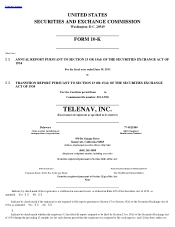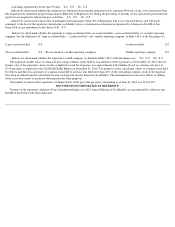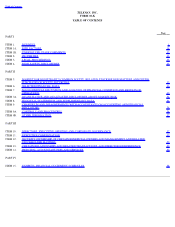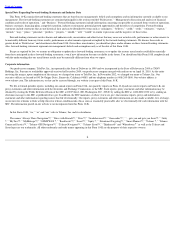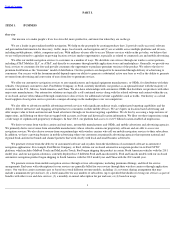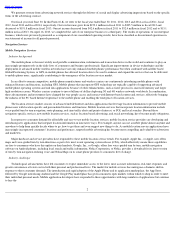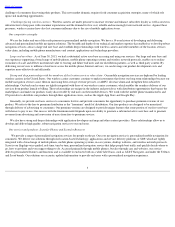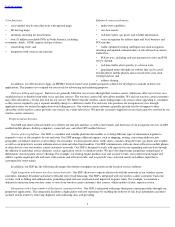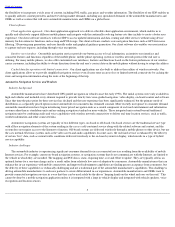TeleNav 2013 Annual Report Download - page 10
Download and view the complete annual report
Please find page 10 of the 2013 TeleNav annual report below. You can navigate through the pages in the report by either clicking on the pages listed below, or by using the keyword search tool below to find specific information within the annual report.
Table of Contents
the flexibility to incorporate a wide array of content, including POI, traffic, gas prices and weather information. The flexibility of our SDP enables us
to quickly add new content providers and meet evolving market demands, including any specialized demands of the automobile manufacturers and
OEMs as well as content that will serve automobile manufacturers and OEMs on a global basis.
Client software
Client application approach . Our client application approach is to deliver a flexible client application environment, which enables us to
quickly and effectively support different mobile phones and integrate with the continually evolving feature sets they include to create a better user
experience. Our client software interfaces with our SDP to access updated information and data, routing and other services without using device
memory for data intensive functions such as map and POI storage. Our client software conducts core navigation functions such as GPS data noise
filtering, 3D moving map generation, and user friendly audio and graphical guidance generation. Our client software also enables our user interface
to capture end user requests, including through voice recognition.
Intuitive user interface . Our mobile navigation services provide one-button access to local information, an intuitive user interface and
consistent features and functions regardless of the mobile phone, mobile phone operating system or wireless network protocol the end user is
utilizing. For many mobile phones, we also offer customized user interfaces, features and functions based on the feature preferences of our wireless
carrier customers, including the ability to obtain directions from the end user's contact data on the mobile phone without having to retype the address.
Cached data for operation with limited connectivity . Our client applications are also built to address the realities of wireless networks. Our
client applications allow us to provide simplified navigation services even if users enter an area of no or limited network connectivity by caching the
route and navigation information along the route at the beginning of the trip.
Automotive Navigation Services and Products
Industry background
Automobile manufacturers have distributed GPS guided navigation in vehicles since the early 1990s. The initial systems were only available in
high end vehicles and included every element required to provide turn by turn voice-guided navigation: video display, on-
board content and software.
Since that time the price point for these services has declined and the user experience has been significantly enhanced, but the primary mode of
distribution as a separately priced option in most automobiles for consumers has remained constant. More recently in response to consumer demand,
automobile manufacturers have begun introducing lower priced navigation units as a central component of on-board entertainment and information
systems rather than as standalone units and are making navigation standard on more vehicles. These integrated units extend beyond traditional
navigation units by combining audio and voice capabilities with wireless network connectivity to deliver real time location services, such as traffic,
weather information and other connected data.
Automotive navigation systems are typically of two different types, on-board or off-board. On-board services are the traditional service type
with all key navigation elements of the system residing in the car as a self-contained service along with the related software and content, and the
system does not require access to the Internet to function. Off-
board systems are delivered wirelessly through a mobile phone or other device, but use
the car's internal electronic systems such as the video screen and audio capabilities. In some cases, the on-board service is enhanced by the delivery
of certain “live” data, such as current traffic conditions delivered wirelessly to the on-board system for display, which results in a type of hybrid
service capability.
Industry challenges
The automobile industry is experiencing significant consumer demand for in-car connected services resulting from the availability of mobile
Internet services. For example, current on-board navigation systems, or navigation systems that do not communicate with the Internet, are limited to
the vehicle in which they are installed. The mapping and POI data is static, requiring time, cost and effort to update. They are typically sold as an
optional feature for a one-time charge and as a result suffer from relatively low rates of adoption by consumers. Automobile manufacturers that can
enhance the in-car experience with mobile connectivity and improved infotainment capabilities are finding greater acceptance from consumers, but
the delivery of these capabilities is technically challenging and not a traditional part of the automobile manufacturer's capabilities. This challenge is
driving automobile manufacturers to seek new partners to create differentiated in-car experiences. Automobile manufacturers and OEMs want to
provide connected navigation services in a way that they can be used safely by the driver “keeping hands on the wheel and eyes on the road.” This
cannot be done by a mobile navigation application unless it is integrated with a large in-vehicle display and integrated with vehicle speakers, voice
recognition and location sensors.
5


